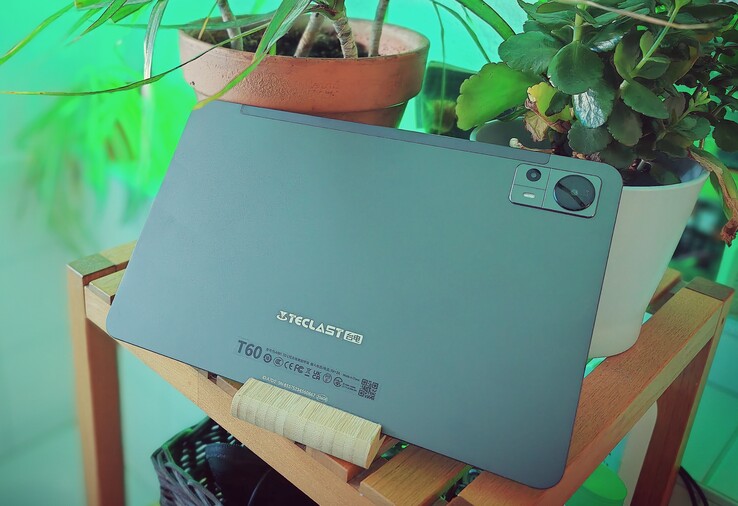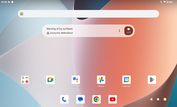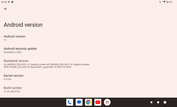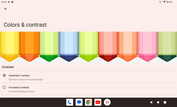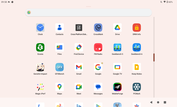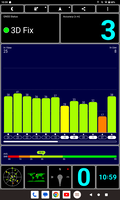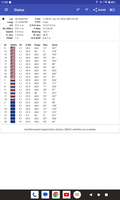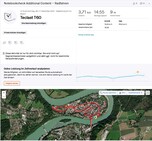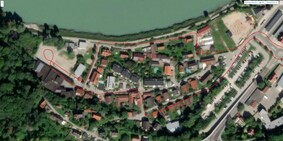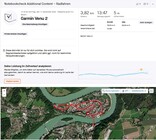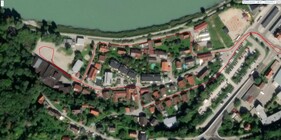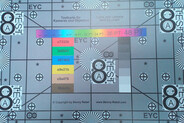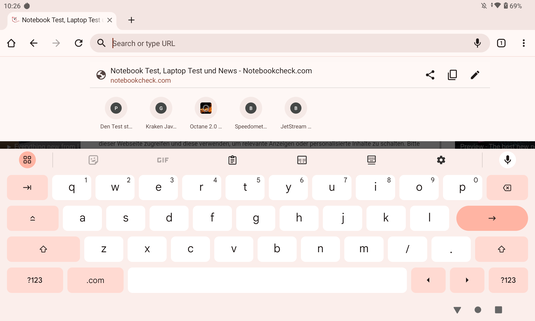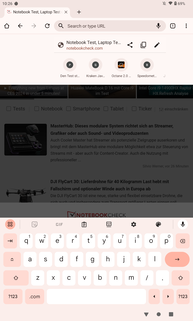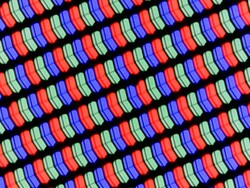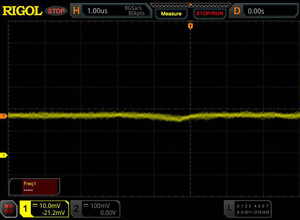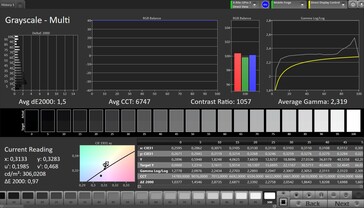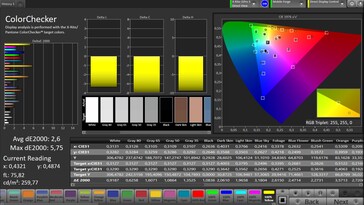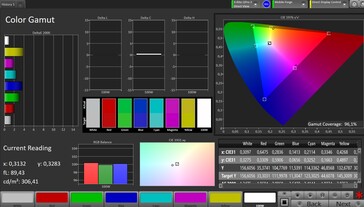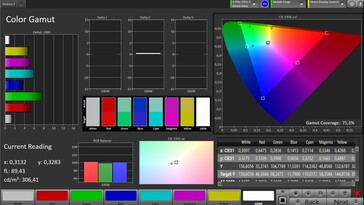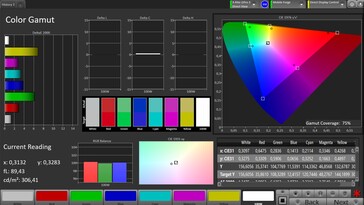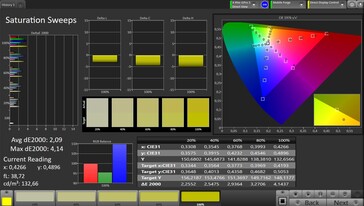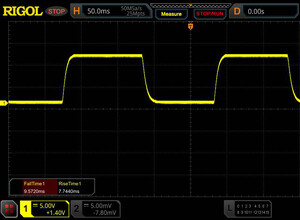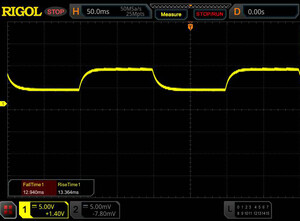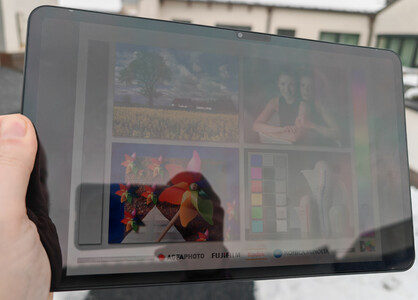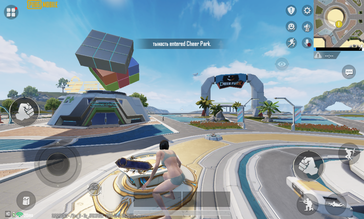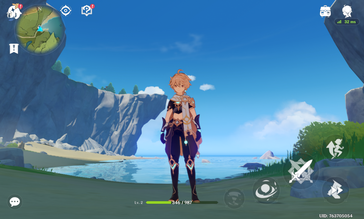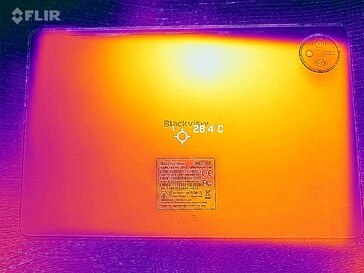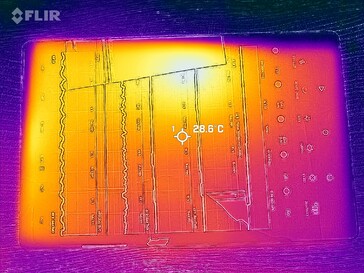Teclast T60 in review – 12 inch tablet with a huge battery
The Teclast T60 stands out as one of the largest tablets in the Chinese producer's lineup, featuring a nearly 12-inch screen that provides ample space for activities such as watching movies or editing documents.
Priced at less than ~$300, purchasers of the T60 can still enjoy a metal case, a cellular modem, and a substantial battery.
However, cost-cutting measures become apparent when examining the charging speed and the SoC specifications in the data sheet. Let's delve deeper to determine whether the Teclast T60 remains a worthwhile choice and for whom it might be most suitable.
Possible competitors compared
Rating | Date | Model | Weight | Height | Size | Resolution | Price |
|---|---|---|---|---|---|---|---|
| 80.7 % v7 (old) | 01 / 2024 | Teclast T60 T7255 (T616), Mali-G57 MP1 | 570 g | 7.7 mm | 11.97" | 2000x1200 | |
| 80 % v7 (old) | 11 / 2023 | Teclast T40 Air T7255 (T616), Mali-G57 MP1 | 464 g | 7.7 mm | 10.36" | 2000x1200 | |
| 83.3 % v7 (old) | 09 / 2023 | Amazon Fire Max 11 MT8188J, Mali-G57 MP2 | 490 g | 7.5 mm | 11.00" | 2000x1200 | |
| 86.5 % v7 (old) | 09 / 2023 | Huawei MatePad 11.5 SD 7 Gen 1, Adreno 644 | 499 g | 6.85 mm | 11.50" | 2200x1440 | |
| 83.5 % v7 (old) | 01 / 2024 | Xiaomi Redmi Pad SE SD 680, Adreno 610 | 481 g | 7.36 mm | 11.00" | 1920x1200 |
Case - Sturdy metal housing
Teclast refers to the T60's colour as Space Grey, unmistakably drawing inspiration from Apple. The metal case boasts a polished finish, free of sharp edges, providing a comfortable feel in the hand. The casing shows sturdiness, requiring deliberate effort to leave pressure marks on the liquid crystal screen.
A noteworthy detail is the shiny metallic red standby button, adding a touch of flair to an otherwise understated design. At the top edge, a slightly darker plastic strip is incorporated to enhance reception for the tablet's various antennas.
While there are more compact and lightweight tablets available in this price range, the Teclast T60's weight of 570 grams is deemed reasonable, particularly when considering its expansive screen size.
Connectivity – Plenty of storage in the Teclast tablet
Without a doubt, the Teclast T60 outperforms many devices in its pricing range in terms of memory. With 8 GB of RAM and an amazing 256 GB eMMC memory for data storage, it surpasses most other devices at comparable prices.
Even though the producer claims to have even more RAM, this is actually accomplished by using a swap file on the data storage. Nevertheless, this is a very slow approach and is unlikely to provide considerable advantages for most programmes given the existing large RAM capacity.
Unlike most Teclast tablets that feature a 3.5 mm audio port, the Teclast T60 opts for exclusivity: audio devices can only be connected via cable through the USB-C port, utilizing an adapter if necessary. It's important to note that this port supports a maximum USB 2.0 speed.
The SIM card holder provides the flexibility to insert either 2 nano-SIMs or a combination of a SIM and a microSD for memory expansion.
microSD card reader
During our testing, we assessed the microSD reader using the Angelbird V60, our designated reference microSD card. The Teclast T60 demonstrated a respectable data transfer rate of just under 30 MB/s, with the reader showcasing performance at a class level in the CPDT benchmark.
It's worth noting, that the tablet falls short of fully harnessing the memory card's potential read rates of 260 MB/s during reading and 140 MB/s during writing. Despite achieving decent data transfer speeds, the Teclast T60 does not maximize the capabilities of the microSD card in terms of read and write rates.
| SD Card Reader - average JPG Copy Test (av. of 3 runs) | |
| Teclast T60 (Angelbird V60) | |
| Xiaomi Redmi Pad SE (Angelbird AV Pro V60) | |
| Teclast T40 Air (Angelbird V60) | |
| Amazon Fire Max 11 (Angelbird AV Pro V60) | |
Cross Platform Disk Test (CPDT)
Software – Pure Android, but the wrong version
Teclast advertises Android 14 on its website, but our test device comes pre-installed with Android 13. However, this suggests a forthcoming update is in the pipeline, even though the manufacturer remains non-committal and is still finalizing an update plan for all devices.
On a positive note, the Teclast T60 actively addresses security concerns, featuring up-to-date security patches as of December 2023 on our test device.
The device offers a refreshing experience by providing a clean Android interface without any bloatware or intrusive advertising apps. This approach ensures ample storage space without the need to uninstall unwanted programs.
Additionally, Teclast has obtained Widevine L1 certification, allowing users to enjoy high-definition streaming of copy-protected content—an appreciated feature for those who prioritize video streaming quality.
Communication and GNSS - Mobile radio is also possible
The tablet connects to a Wi-Fi network using the Wi-Fi 5 standard. In our test with the Asus ROG Rapture AXE11000 reference router, it achieved suitable transfer rates ranging from approximately 300 to 370 MBit/s. These transfer rates remained relatively stable over the entire test period.
Close to the router, where the signal strength is at its maximum, websites load quickly. However, at a distance of 10 meters, the signal indicator drops to 50%, and a noticeable delay occurs when loading websites.
While there are tablets like the Huawei MatePad 11.5, equipped with WiFi 6, enabling better utilization of a gigabit Internet connection, the Teclast T60's Wi-Fi module still performs well overall.
Notably, the tablet is not limited to Wi-Fi connectivity but also supports mobile Internet via a WWAN modem with a maximum 4G standard, allowing for phone calls as well.
Although the frequency diversity is somewhat limited, it proves sufficient for US use. Throughout our approximately three-week test, periodic signal strength comparisons with high-end smartphones revealed that the Teclast T60 consistently delivers commendable reception quality.
| Networking | |
| iperf3 receive AXE11000 | |
| Huawei MatePad 11.5 | |
| Amazon Fire Max 11 | |
| Teclast T60 | |
| Teclast T40 Air | |
| Xiaomi Redmi Pad SE | |
| iperf3 transmit AXE11000 | |
| Huawei MatePad 11.5 | |
| Amazon Fire Max 11 | |
| Xiaomi Redmi Pad SE | |
| Teclast T60 | |
| Teclast T40 Air | |
The Teclast T60 is equipped with a tracking module compatible with all major satellite networks. When stepping outside and waiting a few seconds, the system detects enough satellites to locate you within a 3-meter range. Compared to other devices in the same location, the T60 connects to significantly fewer satellites simultaneously.
This discrepancy becomes evident in our practical test, where we conducted a bike ride with the Garmin Venu 2 smartwatch as a comparison device. Periodically, the T60 places us on incorrect paths parallel to the route, and at times, it records a route that navigates through front gardens and houses. Especially in narrow streets of the old town and when crossing a bridge, the system often loses track entirely.
Consequently, the Teclast tablet is best suited for providing an approximate location. For navigation tasks requiring absolute precision, alternative devices may be more suitable.
Cameras - More of a makeshift
High-quality camera performance is generally not a strong suit of tablets, and unfortunately, the Teclast T60 is no exception. It features a relatively simple 13-megapixel rear camera that tends to capture blurry images with limited dynamic range and partially distorted colors.
Even in low-light conditions, the camera struggles to produce sharp images, with minimal detail visible in both very bright and very dark areas.
Video recording capabilities are limited to a maximum of 1,080p at 30 fps. The autofocus often requires a slightly longer adjustment phase before achieving a truly sharp image.
The front-facing camera, with a resolution of 5 megapixels, also tends to produce somewhat blurred images with a noticeable color cast.
In summary, the cameras on the Teclast T60 are more suitable for tasks like document scanning or reading QR codes rather than meeting the expectations of demanding photographers.
Image comparison
Choose a scene and navigate within the first image. One click changes the position on touchscreens. One click on the zoomed-in image opens the original in a new window. The first image shows the scaled photograph of the test device.
Hauptkamera PflanzeHauptkamera UmgebungHauptkamera Low LightEven with studio lighting, the main camera shows to be rather imprecise in the lab, creating blotchy patches and a picture enveloped in a hazy haze. The colour reproduction is also off.
The camera only records a few details with only 1 lux lighting, but you can still make out the subject overall.
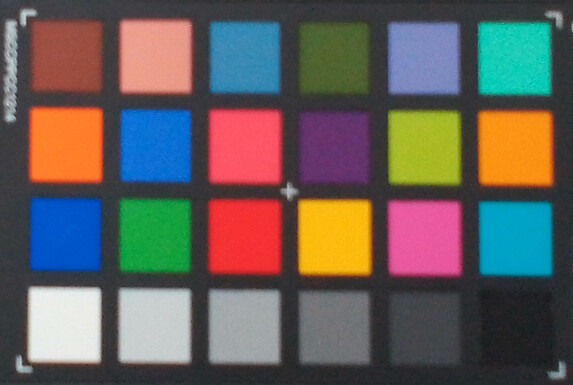
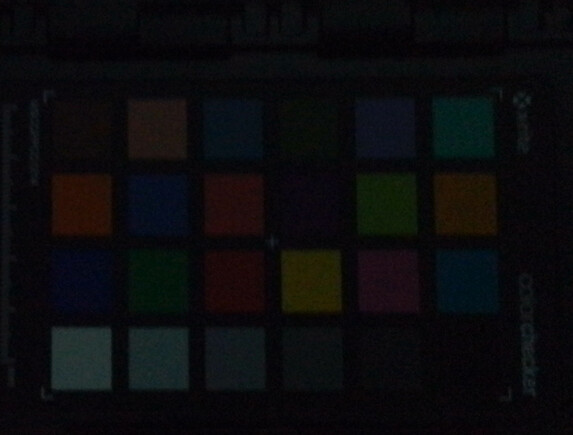
Accessories and warranty - 12 month warranty
Teclast provides a charger, a USB cable, and a SIM tool with the tablet. However, a case needs to be purchased separately.
Regarding warranty, Teclast offers a 12-month limited warranty. The producer also pledges to address and resolve issues within a 24-hour timeframe.
Input devices & operation - Face recognition is possible
The touchscreen on the Teclast T60 proves to be reliable, even in the corners and at the edges. The edges of the casing strike a good balance between a modern aesthetic and effective protection against unintentional touchscreen operations while holding the device.
The physical buttons on the tablet work flawlessly, providing a tactile feel and clear pressure points for user convenience.
It's worth noting that the Teclast T60 does not feature a fingerprint sensor. Biometric unlocking is exclusively available through facial recognition. While the system initially faced challenges registering the user's face, a second attempt was successful and proved to be a swift process thereafter. Subsequently, the facial recognition system reliably unlocks the tablet after a brief waiting period.
Display – Large screen, but not that bright
With its 11.97-inch display, the Teclast T60 provides ample screen space in a 5:3 aspect ratio. This aspect ratio proves to be a good choice as it accommodates 16:9 videos with only narrow stripes at the top and bottom, ensuring comfortable viewing. Additionally, documents can be read and edited conveniently on the spacious screen.
The resolution of 2,000 x 1,200 pixels is sufficient to deliver a good display despite the large screen size.
However, the maximum brightness of 352 cd/m² is relatively moderate, potentially posing challenges for use in brightly lit environments. In comparison, the Amazon Fire Max 11 offers significantly higher brightness in this regard.
| |||||||||||||||||||||||||
Brightness Distribution: 88 %
Center on Battery: 352 cd/m²
Contrast: 1408:1 (Black: 0.25 cd/m²)
ΔE ColorChecker Calman: 2.6 | ∀{0.5-29.43 Ø4.78}
ΔE Greyscale Calman: 1.5 | ∀{0.09-98 Ø5}
96.1% sRGB (Calman 2D)
Gamma: 2.319
CCT: 6747 K
| Teclast T60 IPS, 2000x1200, 12" | Teclast T40 Air IPS, 2000x1200, 10.4" | Amazon Fire Max 11 TFT LCD, 2000x1200, 11" | Huawei MatePad 11.5 IPS, 2200x1440, 11.5" | Xiaomi Redmi Pad SE TFT-LCD, 1920x1200, 11" | |
|---|---|---|---|---|---|
| Screen | -170% | -32% | -38% | -3% | |
| Brightness middle (cd/m²) | 352 | 319 -9% | 564 60% | 472 34% | 473 34% |
| Brightness (cd/m²) | 324 | 296 -9% | 509 57% | 432 33% | 449 39% |
| Brightness Distribution (%) | 88 | 85 -3% | 86 -2% | 86 -2% | 85 -3% |
| Black Level * (cd/m²) | 0.25 | 0.44 -76% | 0.4 -60% | 0.44 -76% | 0.28 -12% |
| Contrast (:1) | 1408 | 725 -49% | 1410 0% | 1073 -24% | 1689 20% |
| Colorchecker dE 2000 * | 2.6 | 10.9 -319% | 4 -54% | 3.4 -31% | 3 -15% |
| Colorchecker dE 2000 max. * | 5.75 | 19.02 -231% | 7.1 -23% | 6.6 -15% | 6 -4% |
| Greyscale dE 2000 * | 1.5 | 11.5 -667% | 5 -233% | 4.8 -220% | 2.7 -80% |
| Gamma | 2.319 95% | 2.035 108% | 2.07 106% | 2.41 91% | 2.27 97% |
| CCT | 6747 96% | 11482 57% | 1168 557% | 7035 92% | 6589 99% |
* ... smaller is better
Screen Flickering / PWM (Pulse-Width Modulation)
| Screen flickering / PWM not detected | |||
In comparison: 53 % of all tested devices do not use PWM to dim the display. If PWM was detected, an average of 8108 (minimum: 5 - maximum: 343500) Hz was measured. | |||
In the test using a spectrophotometer and CalMAN software, it was observed that a fairly accurate color representation can be achieved on the screen when in "Automatic contrast" mode and with a warm white balance. The color accuracy is notable, with only slight distortion in yellow tones, and there is no apparent color cast in the grayscale when viewed with the naked eye.
The screen also does not use PWM to reduce the screen brightness so that even sensitive people can use the tablet.
Display Response Times
| ↔ Response Time Black to White | ||
|---|---|---|
| 17.3 ms ... rise ↗ and fall ↘ combined | ↗ 9.6 ms rise | |
| ↘ 7.7 ms fall | ||
| The screen shows good response rates in our tests, but may be too slow for competitive gamers. In comparison, all tested devices range from 0.1 (minimum) to 240 (maximum) ms. » 38 % of all devices are better. This means that the measured response time is better than the average of all tested devices (20.2 ms). | ||
| ↔ Response Time 50% Grey to 80% Grey | ||
| 26.3 ms ... rise ↗ and fall ↘ combined | ↗ 12.9 ms rise | |
| ↘ 13.4 ms fall | ||
| The screen shows relatively slow response rates in our tests and may be too slow for gamers. In comparison, all tested devices range from 0.165 (minimum) to 636 (maximum) ms. » 35 % of all devices are better. This means that the measured response time is better than the average of all tested devices (31.6 ms). | ||
Outdoor use of the Teclast T60 may be challenging due to the highly reflective screen and the relatively low maximum brightness.
The Teclast T60's screen has excellent viewing angle stability, allowing for visual clarity of the content even at extremely flat viewing angles.
Performance - Sufficient power
The Unisoc Tiger T616 is not a high-performance SoC, but it proves to be sufficient for relatively smooth everyday use. While it may not handle very complex applications seamlessly, the Teclast T60 is well-suited for tasks like watching videos, staying updated on news, and browsing the internet.
It's worth noting that there are more powerful tablets available in the Teclast T60's price range, such as the MatePad 11.5 or the Amazon Fire Max 11.
| CrossMark - Overall | |
| Average of class Tablet (227 - 2155, n=54, last 2 years) | |
| Amazon Fire Max 11 | |
| Xiaomi Redmi Pad SE | |
| Average Unisoc T7255 (T616) (382 - 394, n=4) | |
| Teclast T60 | |
| Teclast T40 Air | |
| UL Procyon AI Inference for Android - Overall Score NNAPI | |
| Average of class Tablet (2597 - 76852, n=62, last 2 years) | |
| Amazon Fire Max 11 | |
| Huawei MatePad 11.5 | |
| Xiaomi Redmi Pad SE | |
| Average Unisoc T7255 (T616) (2817 - 4209, n=5) | |
| Teclast T60 | |
| Teclast T40 Air | |
When it comes to graphics performance, it's obvious that the SoC cannot compete with other similarly priced tablets. This means that only basic benchmarks can run smoothly in the native resolution of the screen.
GFXBench (DX / GLBenchmark) 2.7: T-Rex Onscreen | 1920x1080 T-Rex Offscreen
GFXBench 3.0: on screen Manhattan Onscreen OGL | 1920x1080 1080p Manhattan Offscreen
GFXBench 3.1: on screen Manhattan ES 3.1 Onscreen | 1920x1080 Manhattan ES 3.1 Offscreen
GFXBench: on screen Car Chase Onscreen | 1920x1080 Car Chase Offscreen | on screen Aztec Ruins High Tier Onscreen | 2560x1440 Aztec Ruins High Tier Offscreen | on screen Aztec Ruins Normal Tier Onscreen | 1920x1080 Aztec Ruins Normal Tier Offscreen | 3840x2160 4K Aztec Ruins High Tier Offscreen
| 3DMark / Wild Life Extreme Unlimited | |
| Huawei MatePad 11.5 | |
| Amazon Fire Max 11 | |
| Teclast T60 | |
| Teclast T40 Air | |
| Xiaomi Redmi Pad SE | |
| 3DMark / Wild Life Extreme | |
| Huawei MatePad 11.5 | |
| Amazon Fire Max 11 | |
| Teclast T40 Air | |
| Teclast T60 | |
| Xiaomi Redmi Pad SE | |
| 3DMark / Wild Life Unlimited Score | |
| Huawei MatePad 11.5 | |
| Amazon Fire Max 11 | |
| Xiaomi Redmi Pad SE | |
| Teclast T60 | |
| Teclast T40 Air | |
| 3DMark / Wild Life Score | |
| Huawei MatePad 11.5 | |
| Amazon Fire Max 11 | |
| Xiaomi Redmi Pad SE | |
| Teclast T60 | |
| Teclast T40 Air | |
| 3DMark / Sling Shot Extreme (ES 3.1) Unlimited | |
| Huawei MatePad 11.5 | |
| Amazon Fire Max 11 | |
| Xiaomi Redmi Pad SE | |
| Teclast T60 | |
| Teclast T40 Air | |
| 3DMark / Sling Shot Extreme (ES 3.1) Unlimited Graphics | |
| Huawei MatePad 11.5 | |
| Amazon Fire Max 11 | |
| Xiaomi Redmi Pad SE | |
| Teclast T60 | |
| Teclast T40 Air | |
| 3DMark / Sling Shot Extreme (ES 3.1) Unlimited Physics | |
| Huawei MatePad 11.5 | |
| Amazon Fire Max 11 | |
| Teclast T60 | |
| Teclast T40 Air | |
| Xiaomi Redmi Pad SE | |
| GFXBench (DX / GLBenchmark) 2.7 / T-Rex Onscreen | |
| Amazon Fire Max 11 | |
| Huawei MatePad 11.5 | |
| Xiaomi Redmi Pad SE | |
| Teclast T60 | |
| Teclast T40 Air | |
| GFXBench (DX / GLBenchmark) 2.7 / T-Rex Offscreen | |
| Huawei MatePad 11.5 | |
| Amazon Fire Max 11 | |
| Xiaomi Redmi Pad SE | |
| Teclast T60 | |
| Teclast T40 Air | |
| GFXBench 3.0 / Manhattan Onscreen OGL | |
| Huawei MatePad 11.5 | |
| Amazon Fire Max 11 | |
| Xiaomi Redmi Pad SE | |
| Teclast T60 | |
| Teclast T40 Air | |
| GFXBench 3.0 / 1080p Manhattan Offscreen | |
| Huawei MatePad 11.5 | |
| Amazon Fire Max 11 | |
| Xiaomi Redmi Pad SE | |
| Teclast T40 Air | |
| Teclast T60 | |
| GFXBench 3.1 / Manhattan ES 3.1 Onscreen | |
| Huawei MatePad 11.5 | |
| Amazon Fire Max 11 | |
| Xiaomi Redmi Pad SE | |
| Teclast T60 | |
| Teclast T40 Air | |
| GFXBench 3.1 / Manhattan ES 3.1 Offscreen | |
| Huawei MatePad 11.5 | |
| Amazon Fire Max 11 | |
| Xiaomi Redmi Pad SE | |
| Teclast T60 | |
| Teclast T40 Air | |
| GFXBench / Car Chase Onscreen | |
| Huawei MatePad 11.5 | |
| Amazon Fire Max 11 | |
| Xiaomi Redmi Pad SE | |
| Teclast T60 | |
| Teclast T40 Air | |
| GFXBench / Car Chase Offscreen | |
| Huawei MatePad 11.5 | |
| Amazon Fire Max 11 | |
| Xiaomi Redmi Pad SE | |
| Teclast T60 | |
| Teclast T40 Air | |
| GFXBench / Aztec Ruins High Tier Onscreen | |
| Huawei MatePad 11.5 | |
| Amazon Fire Max 11 | |
| Xiaomi Redmi Pad SE | |
| Teclast T40 Air | |
| Teclast T60 | |
| GFXBench / Aztec Ruins High Tier Offscreen | |
| Huawei MatePad 11.5 | |
| Amazon Fire Max 11 | |
| Xiaomi Redmi Pad SE | |
| Teclast T60 | |
| Teclast T40 Air | |
| GFXBench / Aztec Ruins Normal Tier Onscreen | |
| Huawei MatePad 11.5 | |
| Amazon Fire Max 11 | |
| Xiaomi Redmi Pad SE | |
| Teclast T40 Air | |
| Teclast T60 | |
| GFXBench / Aztec Ruins Normal Tier Offscreen | |
| Huawei MatePad 11.5 | |
| Amazon Fire Max 11 | |
| Xiaomi Redmi Pad SE | |
| Teclast T60 | |
| Teclast T40 Air | |
| GFXBench / 4K Aztec Ruins High Tier Offscreen | |
| Huawei MatePad 11.5 | |
| Amazon Fire Max 11 | |
| Xiaomi Redmi Pad SE | |
| Teclast T60 | |
| Teclast T40 Air | |
When it comes to internet browser speed testing, the tablet merely performs in the midfield. Webpages load quite rapidly, and browsing across images requires little waiting time.
So, speed-wise, daily browsing on the Teclast T60's big screen is quite enjoyable.
| Jetstream 2 - 2.0 Total Score | |
| Average of class Tablet (22.3 - 395, n=68, last 2 years) | |
| Huawei MatePad 11.5 (Edge 115) | |
| Amazon Fire Max 11 (Chrome 116.0.5845.114) | |
| Teclast T60 (Chrome 120) | |
| Teclast T40 Air (Chrome 119) | |
| Xiaomi Redmi Pad SE (chrome 116) | |
| Average Unisoc T7255 (T616) (45.4 - 57.2, n=5) | |
| WebXPRT 4 - Overall | |
| Average of class Tablet (26 - 376, n=71, last 2 years) | |
| Huawei MatePad 11.5 (Edge 115) | |
| Amazon Fire Max 11 (Chrome 116.0.5845.114) | |
| Teclast T60 (Chrome 120) | |
| Teclast T40 Air (Chrome 119) | |
| Xiaomi Redmi Pad SE (chrome 116) | |
| Average Unisoc T7255 (T616) (45 - 60, n=4) | |
| Speedometer 2.0 - Result 2.0 | |
| Average of class Tablet (2.59 - 790, n=55, last 2 years) | |
| Amazon Fire Max 11 (Chrome 116.0.5845.114) | |
| Huawei MatePad 11.5 (Edge 115) | |
| Xiaomi Redmi Pad SE (chrome 116) | |
| Teclast T60 (Chrome 120) | |
| Teclast T40 Air (Chrome 119) | |
| Average Unisoc T7255 (T616) (34.4 - 46.6, n=5) | |
| Octane V2 - Total Score | |
| Average of class Tablet (763 - 138481, n=95, last 2 years) | |
| Huawei MatePad 11.5 (Edge 115) | |
| Amazon Fire Max 11 (Chrome 116.0.5845.114) | |
| Teclast T60 (Chrome 120) | |
| Teclast T40 Air (Chrome 119) | |
| Average Unisoc T7255 (T616) (12141 - 15522, n=6) | |
| Xiaomi Redmi Pad SE (chrome 120) | |
| Mozilla Kraken 1.1 - Total | |
| Average Unisoc T7255 (T616) (2531 - 3014, n=4) | |
| Teclast T40 Air (Chrome 119) | |
| Xiaomi Redmi Pad SE (chrome 116) | |
| Average of class Tablet (243 - 27101, n=80, last 2 years) | |
| Teclast T60 (Chrome 120) | |
| Amazon Fire Max 11 (Chrome 116.0.5845.114) | |
| Huawei MatePad 11.5 (Edge 115) | |
* ... smaller is better
Despite having ample mass storage, the Teclast T60 is comparatively slow in terms of access rates. Even when compared to other tablets with eMMC flash, the tablet registers very low access rates and falls behind devices like the Huawei MatePad 11.5, which uses UFS 2.2 memory.
Users may experience longer loading times and slower data transfers.
| Teclast T60 | Teclast T40 Air | Amazon Fire Max 11 | Huawei MatePad 11.5 | Xiaomi Redmi Pad SE | Average 256 GB eMMC 5.1 Flash | Average of class Tablet | |
|---|---|---|---|---|---|---|---|
| AndroBench 3-5 | 5% | -31% | 359% | 44% | 2% | 417% | |
| Sequential Read 256KB (MB/s) | 240.4 | 270.7 13% | 299.4 25% | 1037.71 332% | 297.47 24% | 278 ? 16% | 1795 ? 647% |
| Sequential Write 256KB (MB/s) | 230 | 246.2 7% | 78.21 -66% | 903.32 293% | 228.97 0% | 214 ? -7% | 1342 ? 483% |
| Random Read 4KB (MB/s) | 76.4 | 76.3 0% | 81.85 7% | 297.25 289% | 102.41 34% | 80.5 ? 5% | 246 ? 222% |
| Random Write 4KB (MB/s) | 67.5 | 67.8 0% | 8.23 -88% | 418.84 521% | 146.92 118% | 63.8 ? -5% | 280 ? 315% |
Games - Gaming for the unpretentious
In the gaming tests conducted on the tablet, it's noted that Teclast's devices do not work with the benchmark software from GameBench, preventing specific frame rates.
Nevertheless, from the observed game settings, it's evident that high performance should not be expected. In games like PUBG Mobile, selecting frame rates of more than 40 fps is not possible even at very low settings. Genshin Impact allows for a maximum of 60 fps, but achieving smooth performance at this level seems challenging based on occasional jerky behavior.
Consequently, the Teclast T60 is better suited for gamers with lower power demands and those who primarily engage in casual gaming.
Emissions - The Teclast T60 has no throttling
Temperature
Even under prolonged load, the case of the Teclast T60 only heats up to a maximum of 33.8 °C (92.84 °F). While this temperature is slightly noticeable, it is by no means unpleasant.
Additionally, the 3DMark stress tests reveal very even curves, indicating that throttling should not be a concern even during extended periods of heavy usage.
(+) The maximum temperature on the upper side is 33.8 °C / 93 F, compared to the average of 33.7 °C / 93 F, ranging from 20.7 to 53.2 °C for the class Tablet.
(+) The bottom heats up to a maximum of 33.8 °C / 93 F, compared to the average of 33.2 °C / 92 F
(+) In idle usage, the average temperature for the upper side is 25.9 °C / 79 F, compared to the device average of 30 °C / 86 F.
3DMark Wild Life Stress Test
| 3DMark | |
| Wild Life Extreme Stress Test | |
| Huawei MatePad 11.5 | |
| Amazon Fire Max 11 | |
| Xiaomi Redmi Pad SE | |
| Teclast T40 Air | |
| Teclast T60 | |
| Wild Life Stress Test Stability | |
| Huawei MatePad 11.5 | |
| Xiaomi Redmi Pad SE | |
| Amazon Fire Max 11 | |
| Teclast T60 | |
| Teclast T40 Air | |
| Wild Life Unlimited Stress Test Stability | |
| Xiaomi Redmi Pad SE | |
Loudspeaker
The tablet includes four speakers, according to the supplier. The maximum volume is sufficient, although it may be a little too quiet in large settings.
When the volume is turned all the way up, it's noted that the treble can sometimes sound unpleasantly overemphasized, but overall, both videos and music can be played on the tablet in good quality.
For those seeking the finest sound quality, the Teclast T60 allows the option to connect headphones or external speakers via USB-C or Bluetooth 5.0. The tablet supports major wireless audio codecs, and users can enjoy Hi-Res music in appealing quality with support for LDAC and aptX HD.
Teclast T60 audio analysis
(±) | speaker loudness is average but good (78 dB)
Bass 100 - 315 Hz
(-) | nearly no bass - on average 20.1% lower than median
(±) | linearity of bass is average (13.8% delta to prev. frequency)
Mids 400 - 2000 Hz
(±) | higher mids - on average 6.8% higher than median
(+) | mids are linear (6.2% delta to prev. frequency)
Highs 2 - 16 kHz
(+) | balanced highs - only 3.1% away from median
(+) | highs are linear (6.8% delta to prev. frequency)
Overall 100 - 16.000 Hz
(±) | linearity of overall sound is average (21.5% difference to median)
Compared to same class
» 65% of all tested devices in this class were better, 5% similar, 30% worse
» The best had a delta of 7%, average was 20%, worst was 129%
Compared to all devices tested
» 60% of all tested devices were better, 7% similar, 33% worse
» The best had a delta of 4%, average was 24%, worst was 134%
Xiaomi Redmi Pad SE audio analysis
(+) | speakers can play relatively loud (88.3 dB)
Bass 100 - 315 Hz
(-) | nearly no bass - on average 25.5% lower than median
(±) | linearity of bass is average (10.3% delta to prev. frequency)
Mids 400 - 2000 Hz
(+) | balanced mids - only 3.7% away from median
(+) | mids are linear (4.1% delta to prev. frequency)
Highs 2 - 16 kHz
(+) | balanced highs - only 1.8% away from median
(+) | highs are linear (2.8% delta to prev. frequency)
Overall 100 - 16.000 Hz
(±) | linearity of overall sound is average (15% difference to median)
Compared to same class
» 33% of all tested devices in this class were better, 3% similar, 63% worse
» The best had a delta of 7%, average was 20%, worst was 129%
Compared to all devices tested
» 20% of all tested devices were better, 4% similar, 76% worse
» The best had a delta of 4%, average was 24%, worst was 134%
Power management - 20 watt charging for the large battery
Power consumption
When compared to other tablets of a similar kind, the Teclast T60 uses less power when it in idle mode. Despite having a bigger screen, it nevertheless manages to use less energy even under medium and high loads.
The tablet can be recharged with up to 20 watts, and a complete cycle from 0 to 100% takes 2:30 hours. All of the chargers we tested, even those made by other producers, worked flawlessly with the tablet.
| Off / Standby | |
| Idle | |
| Load |
|
Key:
min: | |
| Teclast T60 8000 mAh | Teclast T40 Air 7200 mAh | Amazon Fire Max 11 7500 mAh | Huawei MatePad 11.5 7700 mAh | Xiaomi Redmi Pad SE 8000 mAh | |
|---|---|---|---|---|---|
| Power Consumption | -0% | -85% | -114% | -93% | |
| Idle Minimum * (Watt) | 1.2 | 1.2 -0% | 1.04 13% | 1.23 -3% | 0.63 47% |
| Idle Average * (Watt) | 1.4 | 1.3 7% | 4.25 -204% | 4.44 -217% | 4.25 -204% |
| Idle Maximum * (Watt) | 1.7 | 1.5 12% | 4.3 -153% | 4.49 -164% | 4.34 -155% |
| Load Average * (Watt) | 4.2 | 5.6 -33% | 7.62 -81% | 11.2 -167% | 10.24 -144% |
| Load Maximum * (Watt) | 9.5 | 8.4 12% | 9.69 -2% | 11.32 -19% | 10.47 -10% |
* ... smaller is better
Power consumption: Geekbench (150 cd/m²)
Power consumption: GFXBench (150 cd/m²)
Runtimes
The Teclast T60 comes with a large 8,000 mAh battery. It outperforms numerous related devices in terms of runtimes:
For example, users can surf the internet continuously for 18 hours and 16 minutes before the device has to be plugged in. Furthermore, with a runtime of 19 hours and 5 minutes, one can also watch numerous movies stored on the tablet before the power runs out.
Additionally, for gaming enthusiasts, the tablet provides just over 4 hours of gaming fun before requiring a charge.
| Teclast T60 8000 mAh | Teclast T40 Air 7200 mAh | Amazon Fire Max 11 7500 mAh | Huawei MatePad 11.5 7700 mAh | Xiaomi Redmi Pad SE 8000 mAh | |
|---|---|---|---|---|---|
| Battery runtime | -9% | -11% | -25% | 0% | |
| Reader / Idle (h) | 55.2 | 46.8 -15% | 39.7 -28% | 28.4 -49% | 70.6 28% |
| H.264 (h) | 19.1 | 17 -11% | 19.8 4% | 14.6 -24% | 16.6 -13% |
| WiFi v1.3 (h) | 18.3 | 15.3 -16% | 16.5 -10% | 14.4 -21% | 17 -7% |
| Load (h) | 4.2 | 4.4 5% | 3.8 -10% | 4 -5% | 3.9 -7% |
Pros
Cons
Verdict - Good for indoors, average for outdoor use.
Indeed, our comprehensive test reveals that the Teclast T60 excels in various aspects:
The nearly 12-inch screen is generously sized, providing enough space for viewing. The tablet boasts more storage capacity compared to similar devices, and its battery offers substantial energy capacity, leading to above-average runtimes.
Several small details contribute to the tablet's positive performance in these areas. The modern screen design with narrow edges results in a compact device housing a large display. The absence of bloatware and advertising software ensures users have ample space for their own files. Additionally, the tablet's low power consumption contributes to its impressive endurance.
However, there are also drawbacks. The screen falls short in brightness compared to other tablets, the cameras are best suited for snapshots or QR codes, and the overall system performance is at best mediocre. The tracking accuracy is also less than optimal.
The Teclast T60 is a notable addition to any home office or living space. Despite featuring a cellular modem, it is less suitable for outdoor use due to its dark screen and inaccuracies in location tracking.
Alternatives to consider are the notably faster Huawei MatePad 11.5, although it comes with software limitations due to the absence of Google services. Another option is the Amazon Fire Max 11, which provides a bright display but comes with the trade-off of limited Amazon software.
Price and availability
The Teclast T60 is officially priced at $269.99.
Teclast T60
- 01/15/2024 v7 (old)
Florian Schmitt
Transparency
The selection of devices to be reviewed is made by our editorial team. The test sample was provided to the author as a loan by the manufacturer or retailer for the purpose of this review. The lender had no influence on this review, nor did the manufacturer receive a copy of this review before publication. There was no obligation to publish this review. As an independent media company, Notebookcheck is not subjected to the authority of manufacturers, retailers or publishers.
This is how Notebookcheck is testing
Every year, Notebookcheck independently reviews hundreds of laptops and smartphones using standardized procedures to ensure that all results are comparable. We have continuously developed our test methods for around 20 years and set industry standards in the process. In our test labs, high-quality measuring equipment is utilized by experienced technicians and editors. These tests involve a multi-stage validation process. Our complex rating system is based on hundreds of well-founded measurements and benchmarks, which maintains objectivity. Further information on our test methods can be found here.




